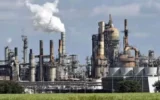Abadan, the Origin of Iranian Oil: The Story of the Country’s Largest Refinery

According to Energy Press, in 1287 AH, with the discovery of oil in Masjed Soleyman, the need to establish a refinery to process this black gold was felt. Abadan Island was chosen as an ideal location for the construction of this refinery due to its strategic location, proximity to oil-bearing areas, location between the Arvand and Bahmanshir rivers, and access to the open waters of the Persian Gulf. Since then, the Abadan Refinery has not only become one of the most important centers for the production of petroleum products, but also played an irreplaceable role in providing energy and supporting the Iranian economy during historical crises, from the world wars to the imposed war. History and beginning of the Abadan Refinery The Abadan Refinery was designed in 1288 AH by the Anglo-Iranian Oil Company and was put into operation in 1291 with an initial capacity of 2,500 barrels per day. As the first Iranian oil refinery, this refinery was a turning point in the history of the country’s oil industry. During World War I, the refinery was expanded to supply fuel to warships, and in World War II, it played a key role in the Allied victory by producing 25,000 barrels of aviation gasoline per day, becoming the largest refinery in the world at the time.
With the cancellation of the Anglo-Iranian Oil Company contract in 1933 and the signing of a new contract, the development of the refinery gained further momentum. The establishment of the Abadan Petroleum College in 1939 to train Iranian manpower was an important step in the self-sufficiency of the oil industry. After the nationalization of the oil industry in 1940, the management of the refinery was entrusted to Iranian employees. In 1955, a contract with the International Petroleum Consortium increased the refinery’s capacity to 300,000 barrels per day. In 1977, with the implementation of expansion plans, the refinery’s capacity increased to 600,000 barrels per day, once again earning the title of the largest refinery in the world.
The Imposed War and Reconstruction
In 1980, with the outbreak of the Imposed War, the Abadan Refinery was the target of heavy attacks due to its proximity to the Iraqi border, and many of its facilities were destroyed. However, the refinery staff, by forming emergency teams and working around the clock, managed to preserve a large part of the equipment and, by sacrificing 244 martyrs, prevented the complete destruction of this national capital. After the war, the first phase of the refinery’s reconstruction, with a capacity of 130,000 barrels per day, was inaugurated by the Supreme Leader (during his presidency) in 1989. Currently, this refinery, with a capacity of 520,000 barrels per day, supplies about 25 percent of the country’s oil products.
Tags:oil
- Comments sent by you will be published after approval by site administrators.
- Comments that contain slander will not be published.
- Comments that are not in Persian or not related to the news will not be published.

Comments
Total comments : 0 Awaiting review : 0 Date: 0